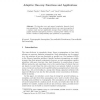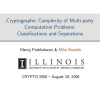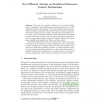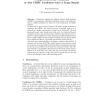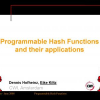119
click to vote
CRYPTO
2008
Springer
15 years 2 months ago
2008
Springer
The Random Oracle Model and the Ideal Cipher Model are two well known idealised models of computation for proving the security of cryptosystems. At Crypto 2005, Coron et al. showed...
CRYPTO
2008
Springer
15 years 2 months ago
2008
Springer
Abstract. We introduce new and general complexity theoretic hardumptions. These assumptions abstract out concrete properties of a random oracle and are significantly stronger than ...
110
click to vote
CRYPTO
2008
Springer
15 years 2 months ago
2008
Springer
In this work we study the design of secure protocols for linear algebra problems. All current solutions to the problem are either inefficient in terms of communication complexity o...
107
click to vote
CRYPTO
2008
Springer
15 years 2 months ago
2008
Springer
In this paper we introduce the notion of a Public-Key Encryption Scheme that is also a Locally-Decodable Error-Correcting Code (PKLDC). In particular, we allow any polynomialtime ...
CRYPTO
2008
Springer
15 years 2 months ago
2008
Springer
101
click to vote
CRYPTO
2008
Springer
15 years 2 months ago
2008
Springer
We present the first general protocol for secure multiparty computation in which the total amount of work required by n players to compute a function f grows only polylogarithmical...
111
click to vote
CRYPTO
2008
Springer
15 years 2 months ago
2008
Springer
Abstract. The study of deterministic public-key encryption was initiated by Bellare et al. (CRYPTO '07), who provided the "strongest possible" notion of security for...
126
click to vote
CRYPTO
2008
Springer
15 years 2 months ago
2008
Springer
The goal of a statistical database is to provide statistics about a population while simultaneously protecting the privacy of the individual records in the database. The tension be...
CRYPTO
2008
Springer
15 years 2 months ago
2008
Springer
A black-box combiner for collision resistant hash functions (CRHF) is a construction which given black-box access to two hash functions is collision resistant if at least one of th...
CRYPTO
2008
Springer
15 years 2 months ago
2008
Springer

